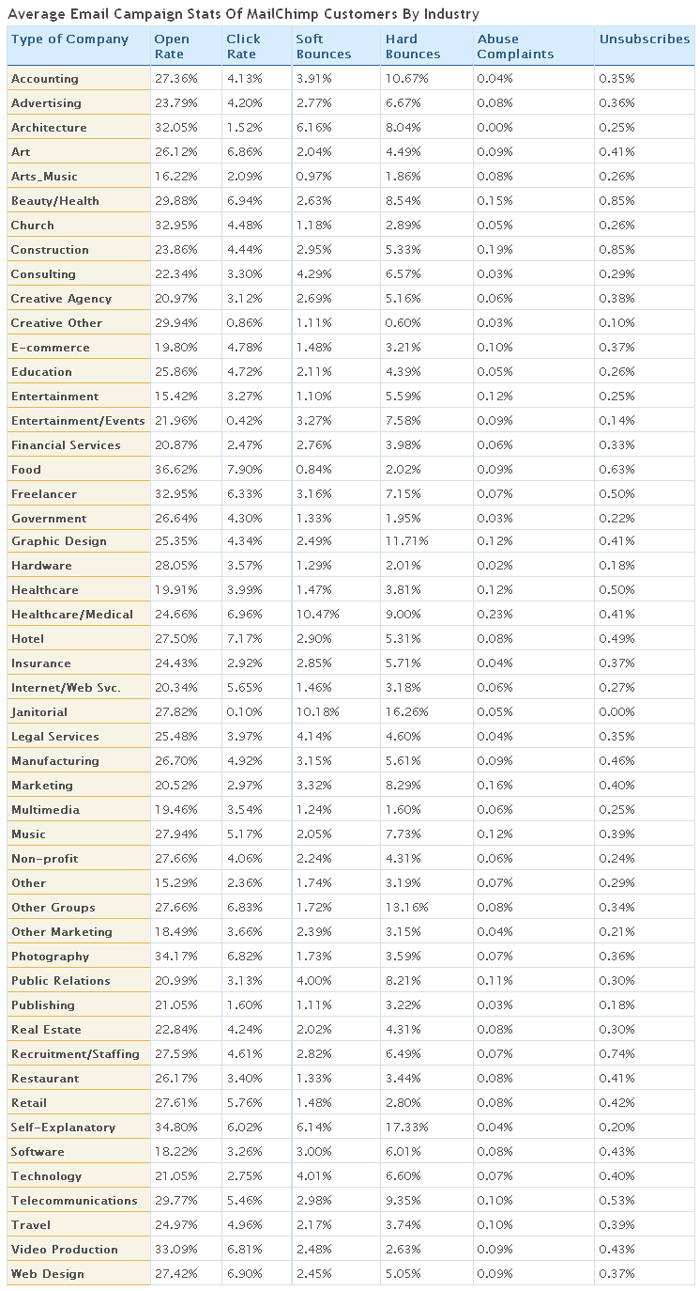Email marketing research: Email open rates by sector
 Here are a few examples of how the email open rates vary between sectors. It’s a report by email specialists MailChimp and it gives an indication of what to expect in any given email campaign. This is useful background but remember the success of your own campaigns will rely on the quality of your list, the value of the information you send and the skill in writing subjectlines and overcoming delivery issues.
Here are a few examples of how the email open rates vary between sectors. It’s a report by email specialists MailChimp and it gives an indication of what to expect in any given email campaign. This is useful background but remember the success of your own campaigns will rely on the quality of your list, the value of the information you send and the skill in writing subjectlines and overcoming delivery issues.
Mailchimp's customers often asked them, "What kind of open rates should companies like mine be expecting?" and "How many bounces are too many?" or, "What's an acceptable abuse complaint rate?"
So they scanned over 273 million emails delivered by their system (where campaign tracking was activated, and where users actually reported their industry) and calculated average open rates, average click rates, average soft bounces, average hard bounces, and average abuse complaint rate by industry.
Best of all, these stats aren't pulled from a survey of big giant corporations with million-dollar marketing budgets and dedicated email marketing teams. 70% of our customers are 1-10 employees, and they're design-it-yourselfers. If you run a small organization, and you do your own email marketing, now you have an "apples to apples" comparison with others in your industry.

Here are some useful tips from the MailChimp Resource Center for improving your email campaign performance
- Boring works best. When you write your subject line, don't sell what's inside---tell what's inside. Read our study on writing effective subject lines.
- If you want people to open your emails, you need to get past their spam filters first. Avoid using spammy keywords and phrases, and avoid using ALL CAPS or too many exclamation points. The best way to avoid spam filters is to learn how they work.
- Too many hard bounces is a sign of an old, stale list. People change email addresses every few months. Make sure you keep in touch with your list regularly (at least once a quarter) so they can stay subscribed to your list.
- Soft bounces usually mean the recipient is "temporarily unavailable." Maybe they're on vacation or their mailbox is full. You can keep those emails and re-try them later (MailChimp auto-cleans soft bounces after 5 failed campaigns).
- Hard bounces mean an email address failed. Maybe it no longer exists, or maybe someone typed their email wrong when they subscribed to a list. But hard bounces might also be spam filter rejections. If you see an abnormally high number of bounces after a campaign, you should read your bounce back records for any messages or "clues" from spam filters (here's how in MailChimp).
- Abuse complaints happen when recipients click the "This is spam" button in their email programs. That usually means they don't remember you. Make sure your "From:" and "Subject" contain your company name (so they'll instantly recognize you). Here are more tips for preventing spam complaints.
Source: https://mailchimp.com/resources/research/email-marketing-benchmarks/.